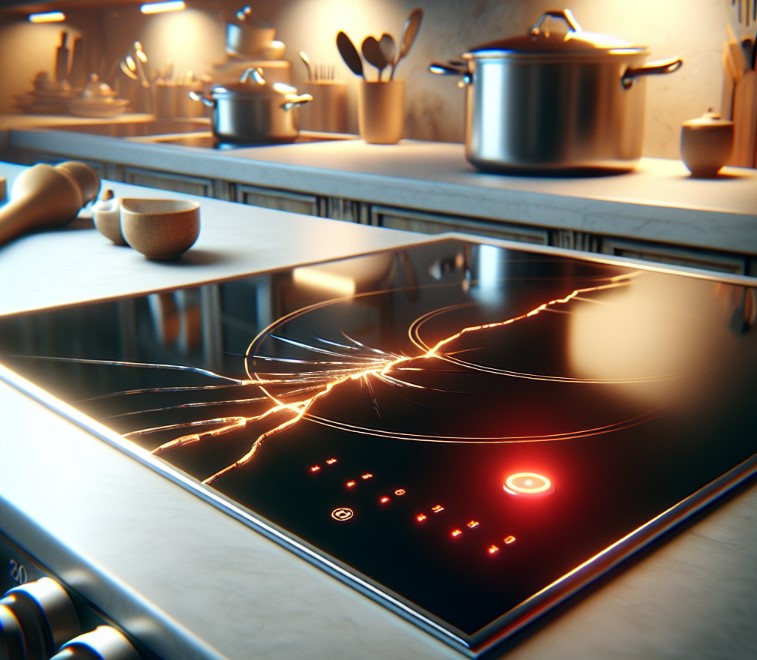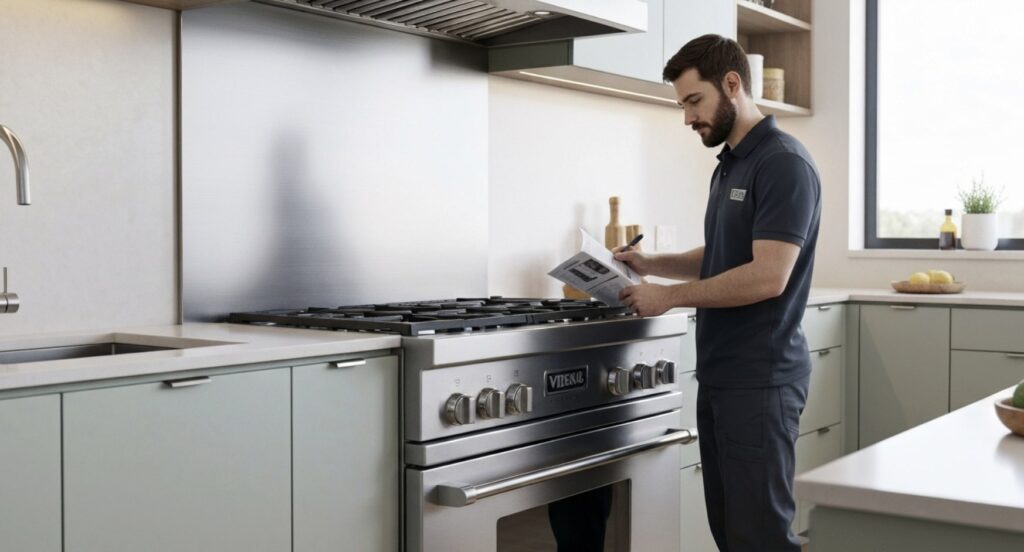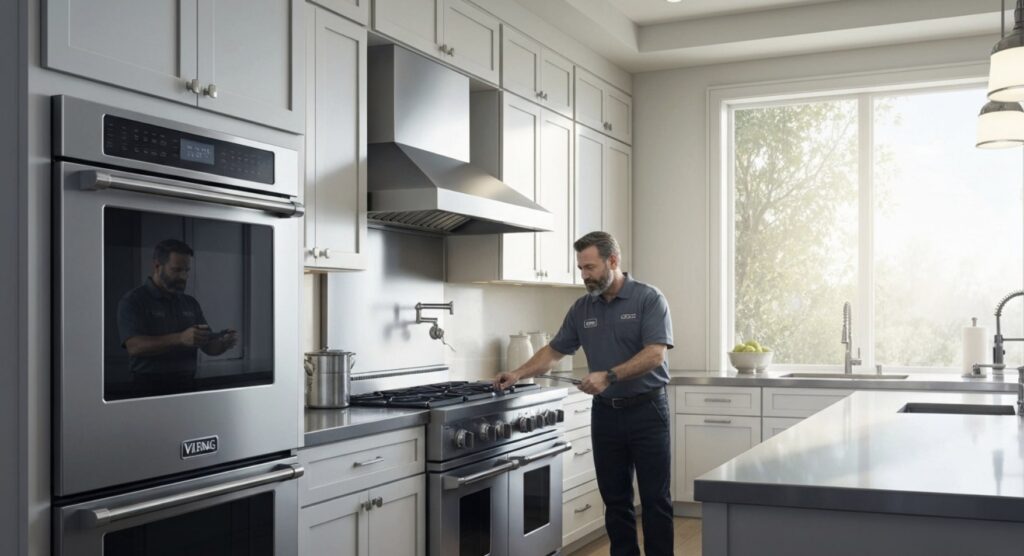A working refrigerator is very important to keep our food fresh. One problem many Viking fridge owners face is when their appliance gets too cold, leading to frozen food. This issue often happens because the internal temperature of the refrigerator is not right. It may be due to wrong temperature settings or other problems. Knowing the usual causes and solutions for a refrigerator freezing food can help fix this issue. In this article, I will discuss common reasons why a refrigerator freezing food and provide some troubleshooting tips to resolve the issue. Let’s dive in!
Common Culprits Behind Freezing Issues in Refrigerators
Many things can cause a refrigerator to freeze food, but finding the main reason can be hard. It’s important to remember that usually a mix of problems causes this, not just one.
So, you need to check different parts of your refrigerator. Look at the temperature settings, air vents, door seals, and how well the defrost system works. By knowing how these parts affect the internal temperature of your refrigerator, you can fix the problem of frozen food effectively.
Blocked Air Vents: A Common Cause for Freezing
Blocked air vents are one of the most common reasons why refrigerators freeze food. These vents help move cold air from the cooling system all around the refrigerator compartment. This keeps the refrigerator temperature steady.
If the vents are blocked, the cold air cannot flow. This causes the cooling to be uneven.
As a result, some spots in the refrigerator, especially near the vents, can get much colder. This can lead to food becoming frozen.
Leaky Door Seal: A Sneaky Culprit
The rubber seal on your refrigerator door is very important. It helps keep the temperature steady inside the refrigerator compartment. If the door seal is damaged or old, cold air can leak out, and warm air can get in.
This change in temperature makes the refrigerator work harder to keep its temperature. If this issue isn’t fixed, it can cause overcooling and frozen food. Usually, refrigerator repair means replacing the damaged door seal to fix the insulation.
Overfilled Fridge: Too Much Can Cause Problems
While it may seem helpful to fill your refrigerator as much as possible, too much food can block air movement. The refrigerator temperature needs good airflow to share the cold air evenly.
When you overcrowd the shelves, it stops the air from moving around. This can create places that are too cold and others that are just right.
As a result, some foods can freeze, while other foods stay at regular temperatures.
Defrost System Issues: A Major Cause of Freezing
Modern refrigerators usually have a defrost system. This system helps stop ice from building up. Ice can interfere with how well the fridge cools. If the defrost system is not working right, it can mess up the do temperature adjustment process.
When the defrost system does not melt the ice, too much frost can build up. This frost can block air vents. When that happens, the temperature inside the refrigerator drops.
If you have problems with the defrost system, you might need to call a repair service. They can find out what is wrong and fix it. This will help your refrigerator control the temperature properly again.
Step-by-Step Guide to Fixing a Refrigerator That’s Freezing Food
Troubleshooting a refrigerator that freezes food requires a simple plan. Before you ask a professional for help, check a few basic things.
Start by making sure the temperature setting is within the recommended range. Then, look at the air vents for any blockages and clear them if you find any. Check the door seals for damage and clean the condenser coils for better performance. Doing these steps can often fix the main reasons why a refrigerator freezes food.
Adjusting the Temperature Control for Optimal Performance
Adjusting the temperature setting is an important first step when fixing a refrigerator that freezes food. You should keep the refrigerator temperature between 37°F and 40°F to preserve food well.
If your refrigerator is colder than this range, it can freeze your food. Begin by slightly raising the temperature setting. After a few hours, check if the freezing issue is still happening.
Keep in mind that a small change can help. It’s best not to make large adjustments in temperature settings. This could upset the refrigerator’s cooling system.
Checking and Cleaning the Coils for Improved Efficiency
The condenser coils of the refrigerator are very important. They help get rid of the heat from the cooling system. Over time, these coils can gather dust, dirt, and other debris. This buildup makes it hard for them to let go of heat efficiently.
When this happens, the compressor has to work harder. This could lead to overcooling and freezing the food. To keep the cooling system working well, you need to clean the condenser coils regularly. You can find the coils at the back or under the refrigerator. Use a vacuum cleaner or a brush to clear the dust.
Cleaning the coils helps stop freezing problems. It also helps your refrigerator last longer, which means less need for refrigerator repair.
The Process of Unblocking Air Vents to Restore Proper Air Circulation
Air vents are important for keeping a steady temperature in the refrigerator compartment. If the air vents are blocked, it stops cold air from flowing well. This can cause some parts of the fridge to be too cold, while other areas are too warm.
To fix this issue, first, find the air vents, which are often located on the back wall of the refrigerator compartment. Take out any items that are blocking the vents to let air flow freely. After you clear the vents, it is good to give the refrigerator some time to adjust its temperature.
This adjustment time helps the cold air move around evenly, making the temperature stable in the whole refrigerator. This can also stop more problems with food freezing.
Preventative Measures to Avoid Future Freezing Issues
Preventing food from freezing in your fridge is about forming good habits and doing simple maintenance. By taking these steps, you can lower the chances of having frozen food.
First, pay attention to how you arrange items in your fridge. Don’t cram too much in there; make sure there is space for air to move around. Check the temperature setting regularly to keep it in a safe range. Also, clean up any spills or leaks quickly to stop ice from forming. Finally, plan regular maintenance checks to keep your fridge working well.
Regular Maintenance Tips for Your Refrigerator
Just like all other appliances, your refrigerator needs regular care. This helps to avoid common issues, such as food freezing. One important task is to check and clean the door gaskets from time to time.
These gaskets seal the door and keep cold air inside, which maintains a steady refrigerator temperature. You should wipe them with warm, soapy water. This will clear away dirt or debris that could damage their seal.
Another key part of taking care of your refrigerator is to make sure there is enough airflow to the cooling system. Don’t push the refrigerator too close to the wall or put items around it that could block air. Good ventilation helps the cooling system work well and lowers the chances of overcooling.
The Significance of Properly Organizing Your Fridge Contents
To keep your refrigerator running well, organize the space inside it properly. This helps it stay efficient and stops temperature problems like freezing.
When air moves freely, the internal temperature stays even in all parts of the refrigerator.
Don’t fill the shelves too much, and make sure food does not block the air vents. These vents are important for letting cold air flow.
Plan where to put your groceries. Place things that need to be colder at the back of the refrigerator, since it is usually cooler there.
This little change can help keep the temperature balanced and reduce the chances of some areas getting too cold and freezing your food.
Why Monitoring Your Refrigerator’s Temperature is Crucial
Keeping your refrigerator at the right temperature is important to keep food safe and fresh. Many things can make the temperature change. This includes the weather outside or opening and closing the door often.
Checking the refrigerator temperature regularly helps you notice any changes. This lets you fix any problems quickly, stopping issues like freezing. A refrigerator thermometer can help you measure the temperature.
Put the thermometer in the center of the refrigerator compartment to get a good reading. Then, adjust the temperature setting as needed to make sure it stays in the recommended range.
Conclusion
To wrap it up, fixing refrigerator freezing food issues means finding some common problems. These usually include blocked air vents, leaky door seals, fridges that are too full, and issues with the defrost system. By using a simple guide to fix these problems and keeping your fridge in good shape, you can prevent them later. This means adjusting the temperature controls, cleaning the coils, and organizing what’s inside the fridge. Regular checks on the temperature and maintenance are very important for a fridge to work well. If you want to know more, look at our blog on Fridge Making Loud Noise Fixes.
Frequently Asked Questions
Why does my refrigerator freeze food even on the warmest setting?
A malfunctioning temperature sensor, control board, or defrost system can cause your refrigerator temperature to drop excessively. Adjusting the temperature setting temporarily may work, but it’s advisable to have the cooling system inspected thoroughly.
Can a faulty door seal cause my fridge to freeze items?
A damaged door seal is a common cause of fridge freezing. Warm air enters through the broken seal, making the cooling system overwork and causing food to freeze. Refrigerator repair typically involves replacing the faulty door seal to address temperature issues.
How often should I clean my refrigerator coils?
Clean your refrigerator coils every three to six months, or more frequently if you have pets or a dusty kitchen. This maintenance task prevents common refrigerator issues and keeps the cooling system running efficiently.
What should I do if adjusting the temperature doesn’t stop the freezing?
If adjusting the temperature doesn’t work, check for blocked vents or a damaged door seal. If the issue persists, contact a professional repair service to identify and fix any refrigerator temperature problems.
Is it normal for the back of the fridge to have ice buildup?
Some frost on the back wall of the refrigerator compartment is normal. However, too much ice is not. It often means there is a problem with the defrost system or the door seal is faulty. This can change the internal temperature. It’s a good idea to get refrigerator repair for the cooling system to stop more problems from happening.







